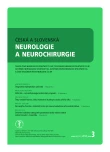The Effect of the Region of Interest Choice on the Results of Pyramidal Tract Representation by Diffusion Tensor Imaging – a Case Report
Authors:
R. Bartoš 1,2; A. Malucelli 1,2; P. Bartoš 2; D. Adámek 3; J. Zárubová 4; M. Sameš 1
Authors‘ workplace:
Neurochirurgická klinika UJEP a Krajská zdravotní a. s., Masarykova nemocnice v Ústí nad Labem, o. z.
1; ICRC – Mezinárodní centrum klinického výzkumu, FN u sv. Anny v Brně
2; Radiodiagnostické oddělení, Krajská zdravotní a. s., Masarykova nemocnice v Ústí nad Labem, o. z.
3; Neurologická klinika 2. LF UK a FN v Motole, Praha
4
Published in:
Cesk Slov Neurol N 2015; 78/111(3): 354-358
Category:
Case Report
doi:
https://doi.org/10.14735/amcsnn2015354
Overview
In our short report, we show the relative nature of pyramidal tract representation using Diffusion Tensor Imaging in a patient with a precentral gyrus glioma and we discuss the factors that may affect tract reconstruction. We believe that, so far, inadequate attention has been paid in the published literature to the region of interest selection even though this is the key determinant of the imaging outcome.
Key words:
glioma – navigation – tractography – electric cortical stimulation
The authors declare they have no potential conflicts of interest concerning drugs, products, or services used in the study.
The Editorial Board declares that the manuscript met the ICMJE “uniform requirements” for biomedical papers.
Sources
Literatura
1. Kamada K, Sawamura Y, Takeuchi F, Kawaguchi H, Kuriki S, Todo T et al. Functional identification of the primary motor area by corticospinal tractography. Neurosurgery 2005; 56 (Suppl 1): 98– 109.
2. Seo JP, Jang SH. Different characteristics of the corticospinal tract according to the cerebral origin: DTI Study. Am J Neuroradiol 2013; 34(7): 1359– 1363.
3. Mandelli ML, Berger MS, Bucci M, Berman JI, Amirbekian B, Henry RG. Quantifying accuracy and precision of diffusion MR tractography of the corticospinal tract in brain tumors. J Neurosurg 2014; 121(2): 349– 358. doi: 10.3171/ 2014.4.JNS131160.
4. Okada T, Mikuni N, Miki Y, Kikuta K, Urayama S, Hanakawa T et al. Corticospinal tract localization: integration of diffusion‑ tensor tractography at 3– T MR imaging with intraoperative white matter stimulation mapping – preliminary results. Radiology 2006; 240(3): 849– 857.
5. Berman JI, Berger MS, Chung S, Nagarajan SS, Henry RG.Accuracy of diffusion tensor magnetic resonance imaging tractography assessed using intraoperative subcortical stimulation mapping and magnetic source imaging. J Neurosurg 2007; 107: 488– 494.
6. Bello L, Gambini A, Castellano A, Carrabba G, Acerbi F. Motor and language DTI Fiber Tracking combined with intraoperative subcortical mapping for surgical removal of gliomas. NeuroImage 2008; 39(1): 369– 382.
7. Zolal A, Hejčl, Vachata P, Bartoš R, Humhej I, Malucelli Aet al. The use of diffusion tensor images of the corticospinal tract in intrinsic brain tumor surgery; a comparison with direct subcortical stimulation. Neurosurgery 2012; 71(2): 331– 340. doi: 10.1227/ NEU.0b013e31825b1c18.
8. Ostrý S, Belšan T, Otáhal J, Beneš V, Netuka D. Is intraoperative diffusion tensor imaging at 3.0T comparable to subcortical corticospinal tract mapping? Neurosurgery 2013; 73(5): 797– 807. doi: 10.1227/ NEU.0000000000000087.
Labels
Paediatric neurology Neurosurgery NeurologyArticle was published in
Czech and Slovak Neurology and Neurosurgery

2015 Issue 3
Most read in this issue
- Addenbrooke’s Cognitive Examination – Approximate Normal Values for the Czech Population
- Spinal Shock – from Pathophysiology to Clinical Manifestation
- Diagnosis of Epileptic Seizures
- Air Embolism of the Brain – a Case Report
